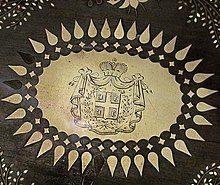Intarsia


Intarsia is a form of wood inlaying that is similar to marquetry. The start of the practice dates from before the seventh century AD. The technique of intarsia inlays sections of wood (at times with contrasting ivory or bone, or mother-of-pearl) within the solid wood matrix of floors and walls or of tabletops and other furniture; by contrast marquetry assembles a pattern out of veneers glued upon the carcass. The word intarsia may derive from the Latin word interserere (to insert).
History
When Egypt came under Arab rule in the seventh century, indigenous arts of intarsia and wood inlay, which lent themselves to non-representational decors and
Intarsia gained popularity in the United States in the 1980s as a wooden art technique using a band saw or scroll saw. Early practitioners made money both by selling their art, and by selling patterns for others to use. In France Georges Vriz proposed a new method for marquetry. Contrary to other techniques, based on a decoration "flat" made of wood or other material, George Virz superimposed the layers of wood using thin, transparent elements that impart color and depth.[4][5]
Process
Intarsia uses varied shapes, sizes, and species of wood fitted together to create a mosaic-like picture with an illusion of depth. Intarsia is created through the selection of different types of wood, using their grain pattern and coloring to create variations in the pattern. After selecting the specific woods for the pattern, the woodworker cuts, shapes, and finishes each piece. Some areas of the pattern may be raised to create more depth. The completed individual pieces fit together like a jig-saw puzzle, glued to a wooden backer-board cut to the outline of the pattern. This typically creates a three-dimensional effect as seen in the
Today intarsia can be made from purchased patterns. To make intarsia from a pattern, first wood is chosen based on color and grain pattern. Next the pattern is transferred onto the wood and individual pieces are precisely cut out on the band saw or scroll saw. The pieces are then sanded individually or in groups to add depth to the piece. Once the sanding is completed, the wood pieces are fitted together to form the final result. A finish (for example a clear gel stain) can be applied to the individual pieces before gluing, or to the glued final version.[6]
See also
- Cosmatesque
- Cosmati
- Damascening
- Duomo di Siena
- Lathart
- Pietra dura
References
- ^ MS Dimand, "An Egypto-Arabic Panel with Mosaic Decoration" The Metropolitan Museum of Art Bulletin, 33.3 (March 1938:78-79)
- ^ Antoine Wilmering, "Domenico di Niccolò, Mattia di Nanni and the Development of Sienese Intarsia Techniques Domenico di Niccolò, Mattia di Nanni and the Development of Sienese Intarsia Techniques", The Burlington Magazine 139 No. 1131 (June 1997:376-97).
- .
- OCLC 52602867.
- OCLC 43366042.
- ^ "Intarsia, How to Do it". Archived from the original on 2015-07-12. Retrieved 23 April 2015.
- Opificio delle Pietre Dure, Florence, an institute of the Ministry for Cultural Heritage
- Jackson, F. Hamilton, Intarsia and Marquetry, (London: Sands & Co.) 1903 excerpt
External links
- Scrollsaw Association of the World website Archived 2021-12-16 at the Wayback Machine
- The Gubbio Studiolo and its conservation, volumes 1 & 2, from The Metropolitan Museum of Art Libraries (fully available online as PDF), which contains material on intarsia (see index)
